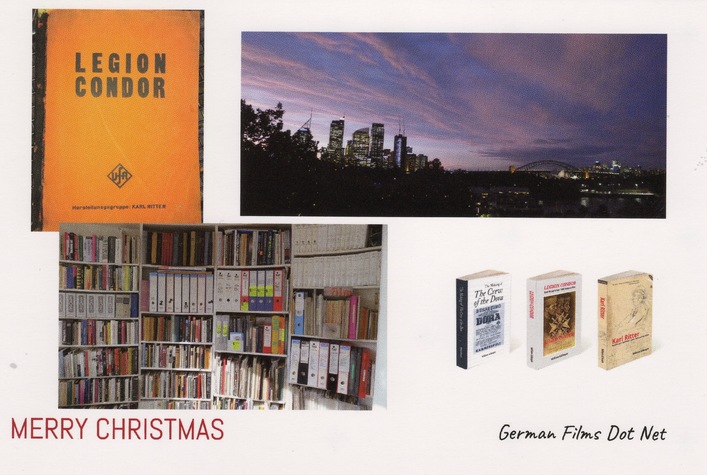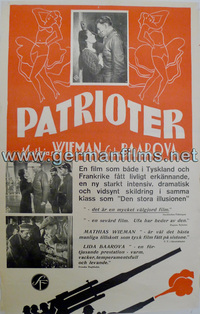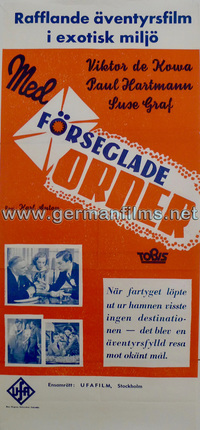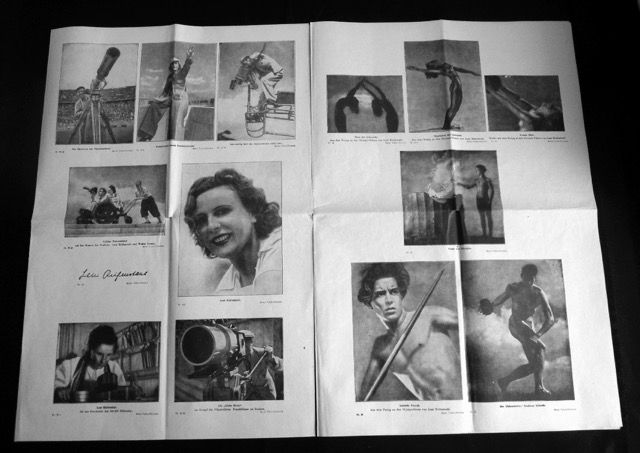- Home
- POSTER GALLERY
- ❗️BOOK & POSTER STORE❗️
- About the Posters
- The William Gillespie Collection
- Our Publishing House
- ❗️GFDN interviews author and collector William Gillespie ❗️
- Our most expensive & inexpensive finds!
- ❗️***NEW!*** Poster of the Month ❗️
- ❗️NEW ❗️Film Posters – Demands on an important means of film advertising. ❗️
- In our Book + Zeitschrift Library
- ❗️ ***NEW!*** Hitler Youth Quex – A Guide for the English–speaking Reader ***NEW!*** ❗️
- ❗️***NEW!*** Table of Contents of our new HJ QUEX book❗️
- ❗️Hitler Youth Quex Guide - early praise! ❗️
- Recent loans from the Collection
- Farewell Horst Claus. (1940–2024)
- "Der Deutsche Film" Zeitschrift
- ❗️ ***NEW!***German "Tendency" Films (Tendenzfilme) in the Third Reich ❗️
- KARL RITTER
- Karl Ritter original film posers in this Collection
- "Besatzung Dora" ( † 1943)
- "The Making of The Crew of the Dora"
- Karl Ritter at the 1938 Reichsfilmkammer Congress
- INDEX -"Karl Ritter" book, 2nd edition
- Karl Ritter's Legion Condor (1939, unfinished)
- Excerpt from our "Dora" book
- ∆∆∆∆∆ High praise for our DORA book! ∆∆∆∆∆
- TABLE OF CONTENTS – "Legion Condor"
- § § § § § Early Praise for our LEGION CONDOR book! § § § § §
- ❗️"Das Leben geht weiter" and Karl Ritter ❗️
- Zarah Leander Europe–wide !
- Japan Military Film and Karl Ritter
- Karl Ritter after 1945
- 1935 Film Congress
- Poster Exhibition in Berlin, March 1939
- Potsdam poster exhibition 12 April–25 August 2019
- Leni Riefenstahl's two "Olympia" Films (1938)
- "Ohm Krüger" (1941)
- Emil Jannings
- "Blutendes Deutschland" (1933)
- Hannes Stelzer ( † 1944)
- Klaus Detlef Sierck ( † 1944)
- Film stills
- Reich Film Censorship Offices
- ❗️Dateline: Ufa - April 11, 1945 ❗️
- ❗️***NEW!***The Fate of the German Film Industry in May 1945 ❗️
- Film censorship cards
- Film Archives
- Cinema advertising
- School filmstrips
- ❗️UPDATED❗️ Z F O / Ostland Film G-m-b-H
- Z F O / Herbert Jacobi estate
- ZFO / Ostland Film newspaper articles
- ❗️***NEW!*** Roter Nebel / Red Fog / Red Mist (1942/1943, ZFO) ❗️
- ZFO - Der Rückkehrer - The Returnee (1943/1944)
- The D F G production company
- D I F U
- ❗️ ***NEW!*** "Carl Peters" – Special Collection. ❗️
- "Alcazar" (1940, Genina)
- "Der 5. Juni" (1943, banned)
- ❗️ ***NEW!*** Herbert Selpin and his "Titanic" (1943) ❗️
- ❗️ ***NEW!*** Ein Robinson (1940, Fanck) ❗️
- "Fronttheater" (1942)
- Veit Harlan's Jud Süß and Fritz Hippler's Der Ewige Jude
- Harlan "Jud Süß" trial 1949
- Werner Krauss & JUD SÜß
- Anti-Semitic Film Posters in the Collection
- "Heimkehr" (1941)
- "Hitlerjunge Quex" (1933)
- ❗️***NEW!*** Hitlerjunge Quex in 111 Greater Berlin Cinemas ❗️
- Jürgen Ohlsen
- "S.A.Mann Brand" (1933)
- "In der roten Hölle" (Edgar Neville, 1939)
- "Helden in Spanien" (1938)
- The Spanish Civil War in Film
- Andrews Engelmann (1901 – 1992)
- Deutsche Wochenschau
- Uƒa Feldpost
- Uƒa Kulturfilm – Informationen
- " Die Tochter des Samurai" (1937, Fanck)
- Ufa 25th Anniversary
- Invitations to world premieres
- ❗️***NEW!*** Continental Films, Paris 1940–1944 ❗️
- Film Censorship in Occupied Paris 1942
- "Der Sieg des Glaubens" (1933)
- Wilhelm Althaus Estate
- Weimar Germany posters
- Ufa and the Ordensburgen
- The Gaufilmstelle in our Collection
- "Zwei Welten" (1940)
- "Capriccio" (1938) –Karl Ritter film album
- Unrealised NS Propaganda Films 1934–1945
- German Film Directors accused of "war crimes"
- Australian––themed NS feature films
- "Der Störenfried" / "The Troublemaker"
- What was new in 2014?
- What was new in 2015?
- What was new in 2016?
- What was new in 2017?
- What was new in 2018?
- What was new in 2019?
- What was new in 2020?
- What was new in 2021?
- What was new in 2022?
- What was new in 2023 ?
- What's new in 2024?
- ❗️***NEW!*** Hitler assassination attempt in Karl Ritter film cut❗️
- BESATZUNG DORA private photos
- Just discovered 1942 article on BESATZUNG DORA
- The Karl Ritter Tetralogy
- Google Analytics 2023
- Our first–ever acquisition!
- ❤️"Some of our favourite things....!"❤️
- ERRATUM for our " Hitler Youth Quex Guide"
- Trending
- Vale †
- Our Wants List / 2024 / Wunschliste
- Pop Quiz
- Unsere KARL RITTER Bücher in Deutschland liefbar!
- WHERE to buy our books right now?
- ✉️Contact
 “History is not about the facts. It is about the context and who is telling the story.” —Prof. Milton Fine.
“History is not about the facts. It is about the context and who is telling the story.” —Prof. Milton Fine.
"Who controls the past controls the future: who controls the present controls the past." –– George Orwell in his novel "1984."
"Whoever doubts the exclusive guilt of Germany for the Second World War destroys the foundation of post–war politics." –– Prof. Theodor Eschenberg, Rector, the University of Tübingen.
"If we have our own why in life, we shall get along with almost any how." – Friedrich Nietzsche
POSTER GALLERY --view
over 500 German film
original posters between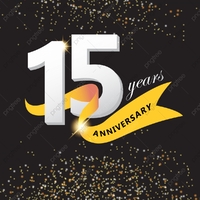
1927–1954 from
Germany and from
many Axis and Neutral countries
across Europe!
Note! Posters in the Poster Gallery are PERMANENT
acquisitions which are NOT FOR SALE!! ONLY the
posters listed in our POSTER STORE are for sale.
(They have a price and order button to use.)
What was new in 2019?
----------------------------------------------------------------------------------------------------------------------------
Our first acquisition of the year is a small collectible, for a film our Collection has represented by two original German posters, Hans Bertram's war film, Kampfgeschwader Lützow. It is the invitation to the film's world premiere of 28 February 1941, issued to someone by Tobis Filmkunst. The premiere took place at Berlin's most prestigious cinema, the Ufa Palast am Zoo. (A hideous post–war cinema edifice now bears the same name, as the original cinema when this film was premiered was a casualty of the war.)



-----------------------------------------–––––––––––––––––––––––––––––––––––––––––––––––––––––––––––––––––––––––––––
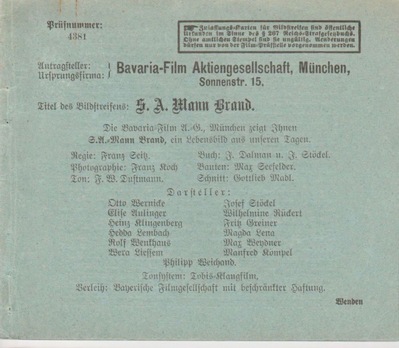
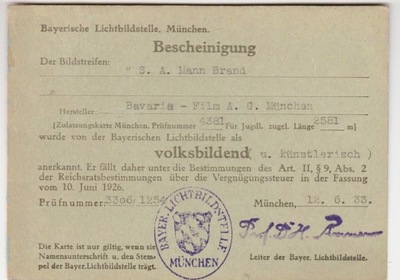
Our second acquisition for the year are the two German Censorship Office cards shown above. These were issued by the Munich branch of the Reichsfilmprüfstelle, which censored all motion pictures for cinema release in Germany. The censorship card is not a simple index card, but actually a multi-paged document of stapled cardstock which has every word of dialogue on the film's soundtrack, as well as each Scene, listed against paragraph numbers for easy visual coordination to a screened final print. The card reflects the final version of the film which is allowed to be shown publicly. The second card, a Prädikat card, was issued in conjunction with the censorship card. This second card provided the film with special attributes for marketing purposes. In this case, "volksbildend" and "künsterlich," or in English 'nation-building' and 'artistic.' Such Prädikate also reduced or exempted cinema owners from paying certain govenmental taxes on the gross box office ticket sales of a film, so were ways the regime encouraged cinema owners to take up the film for their cinema(s).
We are very pleased to have found the original censorship cards for S A MANN BRAND, one of the iconic first propaganda films of the Third Reich. We have in our Collection both of the original German posters for the film, as well as the original "Werberatschlag," (Cinema owner's promotion guide) and some lobby cards as well. Film censorship cards are almost never found for sale on the open market. They are held by various German governmental archives, such as the Bundesarchiv, or in scattered state film institutions; which thanks to the chaos of post–1945 Germany, had many such documents destroyed, lost, burned, or stolen by Soviet forces.
Update: From the same seller, we have purchased the censorship cards for Veit Harlan's Die goldene Stadt (1942) and for the Victor de Kowa 1941 film, Kopf Hoch, Johannes! about an Auslands- HJ boy from Argentina (played by Klaus Detlef Sierck) in a NAPOLA. Both cards super–rare!
-----––––––––––––––––––––––––––––––––––––––––––––––––––––––––––––––––––––––––
Hände Hoch! is our first poster acquisition this year. This was the first feature film of director Alfred Weidenmann. The film is banned today as a Hitler Youth 'Pimpf' film of boys sent to the Tatra Mountains in Slovakia in 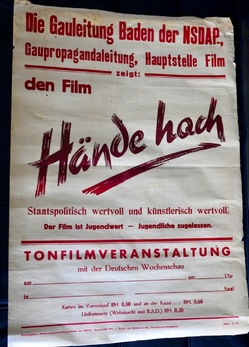 WWII to escape the Allied bombing of their city; and the adventures they had whilst away from home. This is one film for which we have virtually nothing in our collection other than a a few contemporary film newspaper articles; so even though this is not the most exciting poster ever designed, it is a really scarce one. It another example of the Gaufilmstelle (Film distribution and public screening office for regional and rural Germany) poster, of which we have several. Once the poster is in our hands, it will be re–photographed properly and added to our Poster Gallery.
WWII to escape the Allied bombing of their city; and the adventures they had whilst away from home. This is one film for which we have virtually nothing in our collection other than a a few contemporary film newspaper articles; so even though this is not the most exciting poster ever designed, it is a really scarce one. It another example of the Gaufilmstelle (Film distribution and public screening office for regional and rural Germany) poster, of which we have several. Once the poster is in our hands, it will be re–photographed properly and added to our Poster Gallery.
---------------------------------------------------------------------------------------------------------------
We have won at auction the 4 page bi-lingual handbill for the Terra Filmkunst's JUD SÜß, which ties in with our original 1940 poster for that film in our collection.
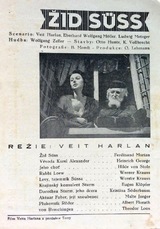
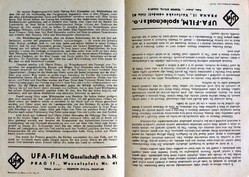
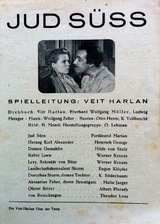
––––––––––––––––––––––––––––––––––––––––––––––––––––––––––––––––––
We have in the past two months, during our proofing and publication of our third Karl Ritter book, Legion Condor – Karl Ritter's lost 1939 feature film, managed to win at auction, to privately purchase, and to swap, three posters, which are being added to our Collection as they arrive from overseas.
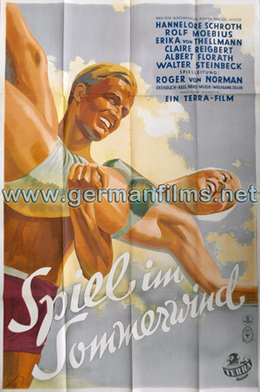

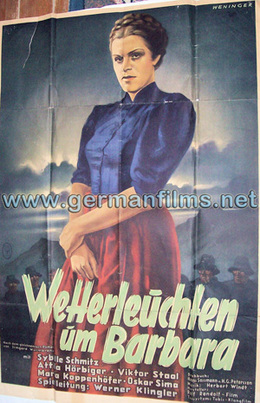
Spiel im Sommerwind is a love story in 1939 Germany between two attractive young people travelling across the Reich; Jakko is the story of a circus boy orphan whose late father's best friend, a circus clown, dies and Jakko is then taken in by a HJ Home and whose life is thus changed for the better; and Wetterleuchten um Barbara is an Anschluss film depicting the struggle of Tyrol mountain farmers against the Austrian authorities leading up the annexation of Austria by the Third Reich.
––––––––––––––––––––––––––––––––––––––––––––––––––––––––––––––
We have acquired three extremely rare Italian original film stills from the 1933 German propaganda fim, Hans Westmar, for which we have a German poster (but not the Italian one.). Also a 4 page Italian language brochure for the film. We have never seen these items before.


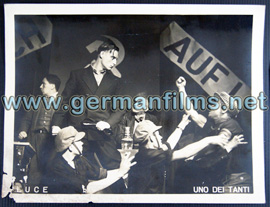
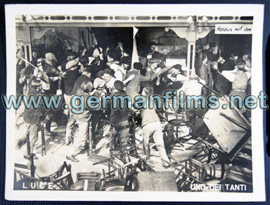
–––––––––––––––––––––––––––––––––––––––––––––––––––––––––––––––––––––––––––––––––––––––––
We won at auction no fewer than 232 original lobby cards for the Deutsche Wochenschau newsreels from Newsreel #150 to #511, running from 1933 to 1945. This Lot was fiercely bid up but we prevailed. The photos are bent, as you can see from this photo we took of them upon delivery, but that can be improved upon. The overall condition of the individual lobby cards is good to very good.

––––––––––––––––––––––––––––––––––––––––––––––––––––––––––––––––––––––––––––––––––––––––––
MORE scarce Film Censorship cards! We have acquired nine more German Film Censorship Office cards for the following German feature films:
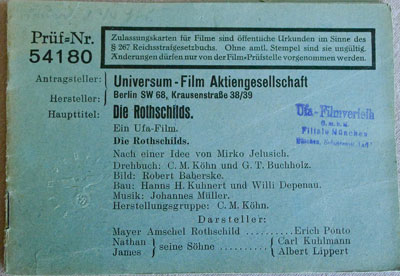
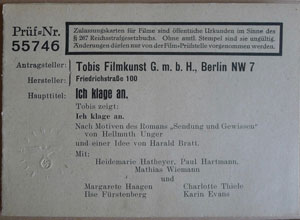
Achtung! Feind hørt mit! (1940)
Bismarck (1940)
Carl Peters (1941, also the 1944 WA card)
Himmelhunde (1942)
Ich klage an (1941)
Die Rothschilds (1940)
Der zerbrochene Krug (1937)
and for the 1932 classic short film starring Karl Valentin,
Im Photoatelier, directed by Karl Ritter (which was Karl Ritter's only short film.)
and the October 21, 1932 censorship card for the NSDAP – Abteilung Film short film (737 meters) of Das junge Deutschland marschiert. This film was banned in Bavaria by the Weimar government.
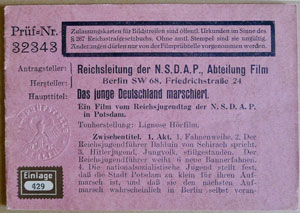
We have also won at auction the rare censorship card for the Spanish Civil War short documentary film, Helden in Spanien, which is examined in our new book on Karl Ritter's lost 1939 feature film on that War, Legion Condor. In Chapter 3, we examine and tell the background and contents of Helden in Spanien, Im Kampf gegen den Weltfeind, and Deutsche Freiwillige in Spanien. This sets the scene in subsequent book chapters, for the telling of the story – for the first time ever – of the evolution, background and actual full film script translated into English, of the never–completed Legion Condor. We are delighted to now own Helden in Spanien's Reich Filmprüfstelle censorship card.
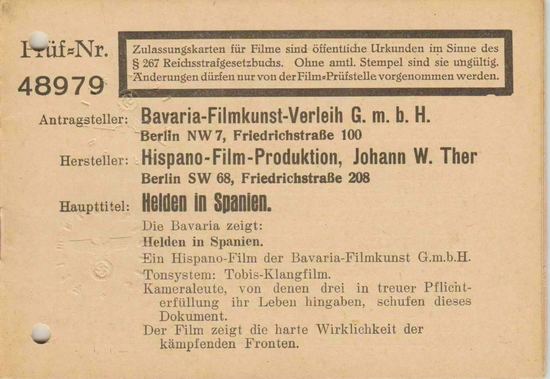
--–––––––––––––––––––––––––––––––––––––––––––––––––––––––––––––––––––––––––––––––––––
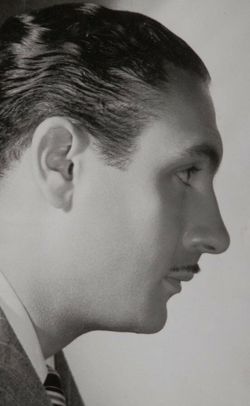 Although 95% of our original posters are for German films, we do have some Italian film posters for Italian films, such as those for Redenzione, Giarabub, Noi Vivi, Bengasi, and for Alcazar. In terms of Spanish film posters from the Franco era, we have a few –– such as the Spanish 1943 poster for the Ufa classic Münchhausen, or for Zarah Leander's Die große Liebe. We also have the Spanish poster from 1940 for Edgar Neville's Frente de Madrid, which was a co–production with Italy where the film was released as Carmen fra i rossi. But heretofore we have not had any posters which were Franco military and/or propaganda films as stand–alone Spanish films.
Although 95% of our original posters are for German films, we do have some Italian film posters for Italian films, such as those for Redenzione, Giarabub, Noi Vivi, Bengasi, and for Alcazar. In terms of Spanish film posters from the Franco era, we have a few –– such as the Spanish 1943 poster for the Ufa classic Münchhausen, or for Zarah Leander's Die große Liebe. We also have the Spanish poster from 1940 for Edgar Neville's Frente de Madrid, which was a co–production with Italy where the film was released as Carmen fra i rossi. But heretofore we have not had any posters which were Franco military and/or propaganda films as stand–alone Spanish films.
We have in our European travels now acquired the 1942 poster for the film Escuadrilla, or Air Squadron, directed by Antonio Roma, shown at the left.
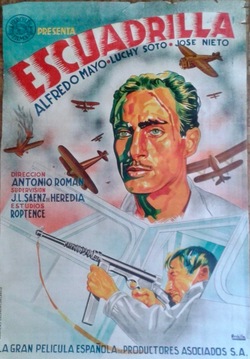
We have also purchased the very scarce 1942 86 pp. publication of Spanish films shown at the Venice Film Festival that year, as Spain's film industry revived after the years of war, when both the Madrid and Barcelona major film centres were held until Franco's victory by the Popular Front and churned out communist, anarchist–syndicalist and Soviet–inspired propaganda.
Below we show the cover to the Venice film catalogue, as well as the double–spread for the Escuadrilla film related to our new poster:
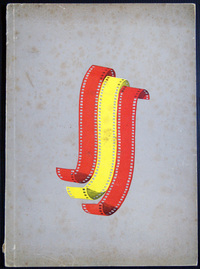

––––––––––––––––––––––––––––––––––––––––––––––––––––––––––––––––––––––––––––––––––––––––––––––––––––
We have traded a duplicate poster once listed in our Poster Store but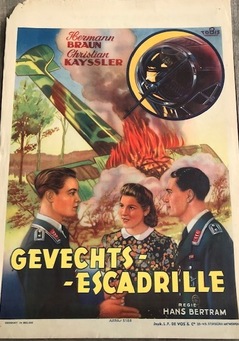 unsold for the Belgian wartime poster for the Hans Bertram Luftwaffe film KAMPFGESCHWADER LÜTZOW, shown here in a photograph provided at the time of the trade. We shall photograph the poster properly when we receive it in June and list it in our Poster Gallery. This is the fifth poster for this film in our Collection. We have both of the original German posters, one from Sweden, and one from Italy too.
unsold for the Belgian wartime poster for the Hans Bertram Luftwaffe film KAMPFGESCHWADER LÜTZOW, shown here in a photograph provided at the time of the trade. We shall photograph the poster properly when we receive it in June and list it in our Poster Gallery. This is the fifth poster for this film in our Collection. We have both of the original German posters, one from Sweden, and one from Italy too.
–––––––––––––––––––––––––––––––––––––––––––––––––––––––––––––––––––
After serving a year in an Allied prison in Rosenheim between June 1945 and June 1946, Karl Ritter was released and re–joined his wife and grown sons and first grandchild in the small village of Oberaudorf a few kilometres from what would become the Austrian border with Bavaria.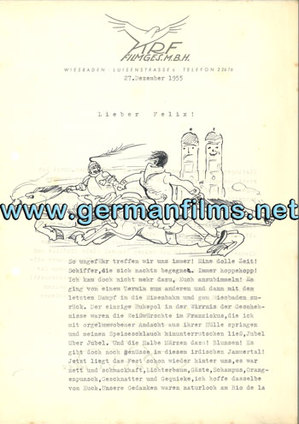 The family had gathered there in April–May 1945 at war's end as a refuge from bombed–out Berlin and the rampaging Red Army, and it was there that Ritter walked on his 24 harrowing day and night trek across Red Army and Partisan lines, after he had escaped from Soviet captivity in the Protektorat/ Czechoslovakia in May/June 1945. His recollection of that incredible escape is printed for the first time ever in our Karl Ritter biography, still in print.
The family had gathered there in April–May 1945 at war's end as a refuge from bombed–out Berlin and the rampaging Red Army, and it was there that Ritter walked on his 24 harrowing day and night trek across Red Army and Partisan lines, after he had escaped from Soviet captivity in the Protektorat/ Czechoslovakia in May/June 1945. His recollection of that incredible escape is printed for the first time ever in our Karl Ritter biography, still in print.
In the years in Oberaudorf the family ecked out an existence which in great part relied on Karl Ritter's graphic skills and artistry. He made souvenirs for American GIs and tourists, painting, etching plates with rustic mountain scenes, and so on. We have just acquired a letter written on April 29, 1947 by Ritter to his film script co–author Felix Lützkendorf, describing life in the village. Lützkendorf co-wrote films scripts for the Ritter films Kadetten, GPU, Über alles in der Welt, Bal Paré, Capriccio, and the never–completed Legion Condor. A second letter we also bought was written in 1955 in Wiesbaden, also to Lützkendorf, when Ritter and wife had returned to Germany for a few years, in an attempt to re–start Ritter's film career in the BRD, once his film work–ban had been lifted. In the many years in which we have searched for original material on or by Karl Ritter, this is the first time we have ever seen original letters written by him on the market. We are delighted to acquire them. The fact that they are written to Lützkendorf, and not to some 'nobody' makes them even more special.
In the Oberaudorf letter from 29 April 1947, Ritter accuses the American occupying soldiers of spreading fear and misery in the village, by confiscating peoples's homes and furnishings, and of barging into the Ritter house demanding to know if they had a carpet, which Ritter had managed to roll up and hide just in time.....
Interestingly, he also mentions actor Paul Hartmann, who starred in some of Ritter's most successful films – Pour le Mérite, Bal Paré, Über alles in der Welt, and was the lead star in the abandoned Legion Condor. He also narrated Ritter's documentary film Im Kampf gegen den Weltfeind.
Ritter's sarcasm about the Denazification process is clear:
"Yesterday was Paul Hartmann's closing date in front of the Rosenheim Denazification Court. I do not know yet, but believe that it went smoothly. He had a very sacral parade, headed by the parish priest of Hohenschau [ the Bavarian village where the Hartmanns had a house. –Editor.] It turned out that Paul always had and always has a touching, childlike piety. The assessors wiped their eyes and gasped with emotion."
Ritter then implores Lützkendorf to think about getting out of Germany. Ritter says that he and his family must get out. This comment indicates how hard life was in Germany in 1947 and how desperate things had become. Both letters a wonderful acquisition to our Collection.
––––––––––––––––––––––––––––––––––––––––––––––––––
 This new acquisition is one of the rarest posters in our entire Collection. It is a re–release 1941 poster for the Harlan film distributed in Hungary. The use of the yellow star is especially interesting, as this clothing badge and armband was not introduced into Hungary until March 1944 -- three years later. (The yellow star was used in conquered Poland as at November 1939 and then in Greater Germany in November 1941. The yellow star was not a symbol found on other non–film posters, and was just seen as something Jews had to wear on their clothing.) Three years before the star was worn by Hungarian Jews, this film poster must have been shocking to cinema–goers in Hungary at the time. The poster is in our Poster Gallery here.
This new acquisition is one of the rarest posters in our entire Collection. It is a re–release 1941 poster for the Harlan film distributed in Hungary. The use of the yellow star is especially interesting, as this clothing badge and armband was not introduced into Hungary until March 1944 -- three years later. (The yellow star was used in conquered Poland as at November 1939 and then in Greater Germany in November 1941. The yellow star was not a symbol found on other non–film posters, and was just seen as something Jews had to wear on their clothing.) Three years before the star was worn by Hungarian Jews, this film poster must have been shocking to cinema–goers in Hungary at the time. The poster is in our Poster Gallery here.
----------------------------------------------------------------------------------------------------------------
We came across this 1940 Ufa film studio book and asked the Munich Antiquariat seller for more details before purchasing it. We had never heard of this title before. It is called "Guidelines for the 1940/1941 film distribution."
The book is 273 pages long. It is a restricted access book for certain Ufa studio staff only:
"This book is to be treated as a confidential document whose contents are to be kept strictly confidential. This numbered copy has been issued against receipt and must be returned to the responsible branch management or the Ufaleih headquarters, Berlin, upon request, without being requested to do so."
Copy 102. Issued to a H. Hess.
The book covers all aspects of Ufa in the Reich, from occupied territories, to advertising, the HJ Filmstunden, to Tonfilmwagen mobile units, etc. Two pages on Ufa television. We are certain that it is an extremely rare book amongst our many other titles, many of which are rare in and of themselves. A superb research source!

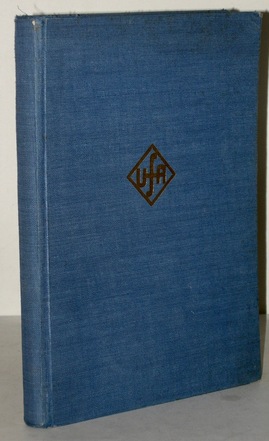
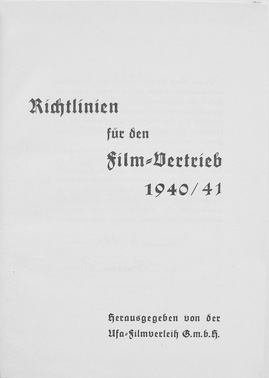
–––––––––––––––––––––––––––––––––––––––––––––––––––––––––––––––––––––
A recent Danish visitor to our site interested in the 1932/1933 NSDAP documentary film Blutendes Deutschland not only made a small donation to our site via our DONATE button, but very kindly alerted us to a film handbill advertising the showing of the film in Blankenese in February 1933 which was for sale on a small militaria website. We have purchased it for the Collection. The uncensored version of the handbill can be found alongside our original poster image of the film in our Poster Gallery.
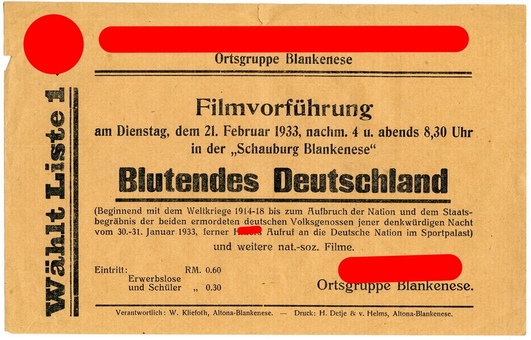
–––––––––––––––––––––––––––––––––––––––––––––––––––––––––––––––––––––––––
We have acquited two small Swedish posters in the traditional "Daybill" type size for Karl Ritter's WWI story Patriots and for Karl Anton's exotic spy film, Under sealed Orders. The Ritter poster is from 1937 and the Anton poster one year later. Both are now photographed and in our Poster Gallery.
-------------------------------------------------------------------------------------------------------
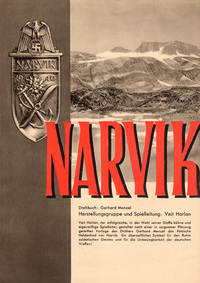 We have added a new page to this website listing over two dozen NS propaganda films which were announced by the major studios between 1934 and 1945, but for various reasons were never produced. The films are listed with a short synopsis or description of what they were meant to tell, and the studio advertisement for them sent to cinema owners and the film industry is also illustrated, when available. [To the left, Veit Harlan's Narvik.]
We have added a new page to this website listing over two dozen NS propaganda films which were announced by the major studios between 1934 and 1945, but for various reasons were never produced. The films are listed with a short synopsis or description of what they were meant to tell, and the studio advertisement for them sent to cinema owners and the film industry is also illustrated, when available. [To the left, Veit Harlan's Narvik.]
You can find the page here.
–––––––––––––––––––––––––––––––––––––––––––––––––––––––––––––––––––––––
We have acquired the very rare original Tobis Filmkunst newspaper style promotion sheet for Riefenstahl's Olympia (1938):
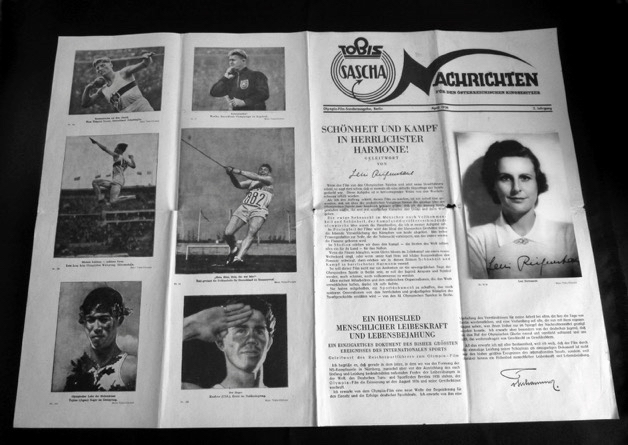
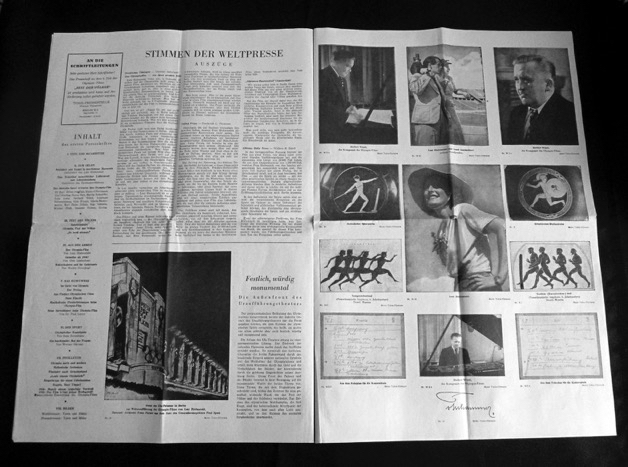
--------------------------------------------------------------------------------------------------------------------------
We have added two rare Imperial Japan film advertising sheets, which unfolded are ca. A3 ( 10 1/2 inches x 14 inches) in size and on the front represent a small film poster and the verso a synopsis and information and stills reprinted on the film. We already had such advertising sheet posters for Riefenstahl's Olympia, Karl Ritter's Unternehmen Michael, and a few other films, so are delighted to have found these two, which have now been scanned into our Poster Gallery.
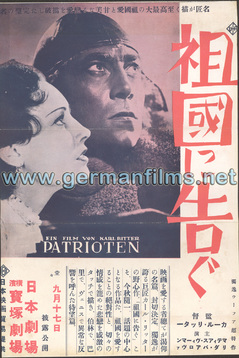

-----––––––––––––––––––––––––––––––––––––––––––––––––––––––––––––––––––––––––
We have won four superb and very rare original Italian film posters at an auction in Turin, Italy. They are for the classic Italian fascist film VECCHIA GUARDIA (Old Guard, aka as "Mario" in German cinemas), for Detlef Sierck's first Zarah Leander film ZU NEUEN UFERN (Uƒa, 1937), for Gustav Ucicky's DAS MÄDCHEN JOHANNA (1935) and a poster for the Edgar Neville anti-Red film, CARMEN FRA I ROSSI (Frente de Madrid/In der roten Hölle).
-----------------------------------------------------------------------------------------------------------------
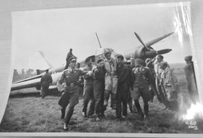 We have purchased a press photograph which we did not have from Karl Ritter's Besatzung Dora. This scene, in which Hauptmann Gillhausen, head of the Ju88 crew, is wounded in action in France, is a key moment in the film. We are delighted to add this rare photo to our collection.
We have purchased a press photograph which we did not have from Karl Ritter's Besatzung Dora. This scene, in which Hauptmann Gillhausen, head of the Ju88 crew, is wounded in action in France, is a key moment in the film. We are delighted to add this rare photo to our collection.
–––––––––––––––––––––––––––––––––––––––––––––––––––––––––––––––––––––––––
The year 2019 in review
The year was one of great satisfaction, adding very rare film treasures, such as the German film censorship cards for SA Mann Brand, Ich klage an, Die Rothschilds, and for the German documentary film Helden in Spanien. The latter film features in our new book Legion Condor – Karl Ritter’s lost 1939 feature film, published in April of this year as the third book which completes our Karl Ritter “Trilogy.”
We added twelve original new film posters to our Collection, including three from Germany, three from Fascist Italy, two from Sweden, one from Franco Spain, two from Occupied Belgium, and one from Hungary. This dozen posters included one for a Karl Ritter film, one of a classic Fascist Movement film from Italy, a Zarah Leander film poster with ‘Sidney’ in the title (the Italian Zu neuen Ufern), and the previously unknown Hungarian poster for Jud Süß.
We also added no less than 232 lobby cards for Deutsche Wochenschau weekly newsreels; and two ultra–rare original letters written and signed by Karl Ritter in 1947 and 1955, respectively.
